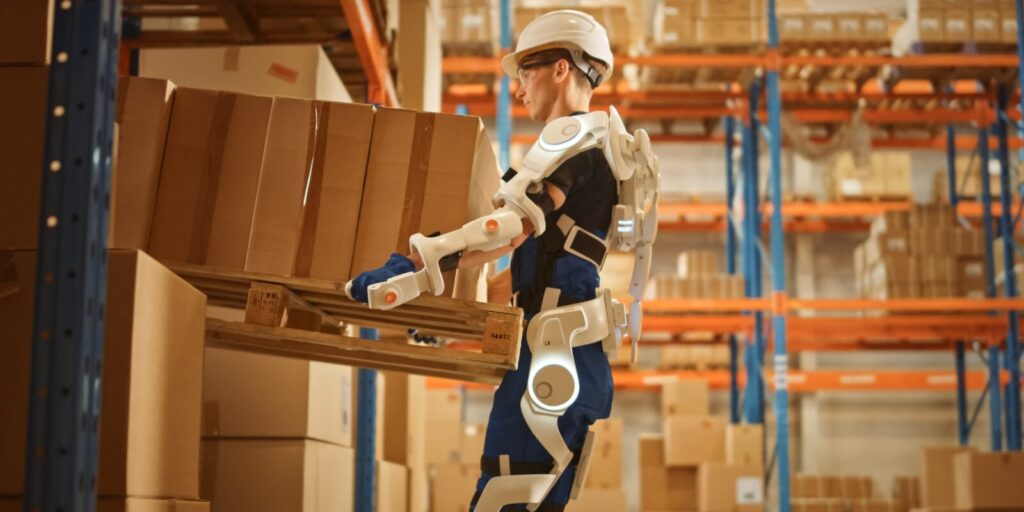By James Rethaber, Ph.D., CPE, LSSMBB
Vice President of Technical Operations, Fit For Work
In recent years, the promises of ergonomic wearables in reducing the risks of musculoskeletal injuries (MSDs) in the workplace have gained significant attention. Wearable device companies advertise these products as tools that can monitor and alleviate awkward postures, ultimately improving employee well-being.
Here, we take a closer look at the two main categories of wearables in the ergonomics realm, the pros and cons of wearables themselves, and a case study to illustrate how to use them effectively in the workplace.
The Two Main Categories of Wearables in Ergonomics
Wearable devices in the world of ergo can be broadly classified into two categories: exoskeletons (both passive and active) and motion-sensing devices.
- Exoskeletons aim to assist users in lifting items or to reduce the force associated with holding certain tools.
- Motion-sensing devices, on the other hand, detect at-risk postures such as bending or twisting and alert the user through vibrations or beeps. This information is typically used to detect high-risk tasks or postural behavioral concerns.
Pros and Cons of Wearable Technology
Before implementing wearables in the workplace, it’s crucial to weigh the pros and cons associated with these devices.
Pros:
- Data Collection: Wearables can collect large amounts of data, aiding in identifying trends within departments and other specific areas.
- Risk Analysis: They can provide highly useful job risk analysis, evaluation, or assessment data.
- Employee Wellness: Wearables can also enhance the quality of employee wellness programs within your organization.
Cons:
- Comfort Issues: Exoskeletons can be bulky and uncomfortable, potentially transferring force to other parts of the body. Wearable sensors may make some movements uncomfortable and/or interfere with normal movements.
- Safety Culture Concerns: There’s a risk of creating a negative safety culture wherein management blames employees for injuries instead of providing constructive coaching.
- Costs: Associated costs, both in terms of purchasing the devices and analyzing the data, can be expensive.
- Compliance Barriers: Large compliance barriers may hinder the successful implementation of wearable technology.
- Data Security: Ensuring the security of personal data collected by wearable sensors is also a significant concern.
Real-World Application: A Case Study
To understand the practical implications of wearables, let’s delve into a real-world example. During a recent visit to a manufacturing facility, Fit For Work Ergonomics Specialist Jacob Wilkins tested a wearable sensor designed to vibrate when the user bends, twists, or reaches excessively. Jacob found the device to be overly sensitive, particularly regarding forward bending movements while maintaining a neutral spine, such as a golfer’s lift/lunge for retrieving lower-weight items from floor level. While it successfully highlighted tasks with repetitive bending, it did not account for best work practices that could mitigate these risks.
Despite its limitations, Jacob used data from the sensor to identify at-risk tasks, allowing him to recommend controls that would mitigate the risk of MSDs. However, he emphasized the importance of visual observation methods and human interaction in determining whether an employee is genuinely at risk. The case study underscores the need for a balanced approach to incorporating wearable technology in the workplace. Human behaviors are complex and require a more comprehensive approach to manage and/or resolve them than simply interpreting numbers, charts, and graphs on a screen.
Navigating Wearables Decision-Making
Now that we’ve covered the pros and cons and how best to balance wearables with human interaction, it’s important to put that information to use within your workplace.
If your leadership team is considering the introduction of wearables in the workplace, thorough research is an essential first step. Exploring scientific data on platforms like Google Scholar and leveraging any existing data from ergonomic specialists can be a great place to start.
However, it’s crucial not to overlook the human factor, either. Make sure you’re taking time to communicate with employees to understand their tasks and the work environment thoroughly. This interaction may reveal alternative controls, such as lift assists or job rotations, that can effectively reduce MSD risk and enhance efficiency.
Elevate All Sides of Your Safety Program with Fit For Work
While the potential benefits of wearables in the workplace are significant, a cautious and informed approach is crucial. By understanding the dos and don’ts, weighing the pros and cons, and incorporating real-world experiences, organizations can make informed decisions about the integration of wearables to improve workplace safety and employee well-being.
Safety in the workplace is about getting ahead of injuries before they happen by cultivating a proactive, results-driven safety program focused on preventing your employees from becoming patients.
Fit For Work achieves this by providing employers at thousands of locations across the country with strategic, consistent support to ensure their workers can experience a safer, happier, and more productive professional life. From onsite early intervention and ergonomics to safety compliance and employee testing, our services are designed to help safety managers and specialists prevent injuries while creating a more productive environment for their workers.





